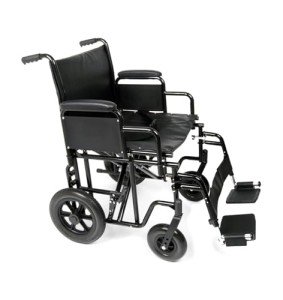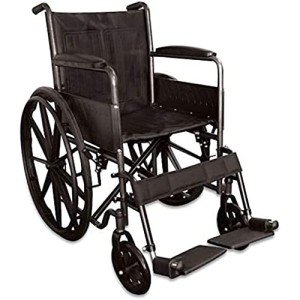What Do You Know About Bariatric Wheelchair 24 Inch Seat?
페이지 정보
작성자 Jeremy 작성일25-04-03 12:48 조회2회 댓글0건관련링크
본문
bariatric heavy duty transport wheelchair Wheelchair Seat Width
Seat Width
Having the correct seat width is important to wheelchair users who invest longer periods in their chairs. Too narrow a seat will trigger pressure on the hips and thighs which might lead to sores or pressure points. Having too large a seat can also make it difficult for the user to reach the hand rims to move themselves or maneuver in little areas.
To measure the right seat width an individual would rest on a chair generally and have their measurement taken across their lap at the best point which is usually their hips. A wheelchair determining tape can be used to determine this, but a yard stick is preferred as it prevents people from covering the tape around their hips which would provide an unreliable result.
The standard wheelchair seat width is 16" (narrow adult), 18" (standard adult), and 20" (large adult). For bariatric electric wheelchairs for sale patients, a 24" seat is available. This durable additional wide bariatric wheelchair from Medline includes swing-away footrests, a carbon steel frame with rust- and chip-resistant chrome plating, and easy-to-clean vinyl upholstery. It has a weight capacity of 500 pounds.
Seat Depth
Generally, the seat depth of a self propelled bariatric wheelchair wheelchair was added 2" to the measurement taken at the user's largest point (generally their hips). This was indicated to accommodate additional layers of clothing that may be used throughout cold weather condition. However, this practice is becoming less common as wheelchair users are able to invest more time inside your home and are not wearing long coats. This makes the seat depth of a chair lesser when picking a bariatric wheelchair. However, it is still essential to choose a choice that uses adequate support for bigger users.
 The Medline folding additional large bariatric manual wheelchair features a comfy 24" seat width and a heavy-duty slide tube silver vein frame. It also has an adjustable axle and tool-free elevating legrests.
The Medline folding additional large bariatric manual wheelchair features a comfy 24" seat width and a heavy-duty slide tube silver vein frame. It also has an adjustable axle and tool-free elevating legrests.
Seat Height
When it concerns figuring out the proper wheelchair seat width you must constantly determine from the user's largest point which is generally their hips. You will likewise need to consider whether the user is going to be using a winter coat as this may include 2" to the width required.
 When a wheelchair is in usage it should only be operated on level surface areas with the wheel locks fully engaged. This is to avoid the chair from having the ability to move slopes that are 10 degrees or higher. It is likewise crucial to keep in mind that any activity that may shift the center of gravity in the chair should be finished with care. This includes reaching for products that need the person to lean out of their seat or attempting to stand up from it.
When a wheelchair is in usage it should only be operated on level surface areas with the wheel locks fully engaged. This is to avoid the chair from having the ability to move slopes that are 10 degrees or higher. It is likewise crucial to keep in mind that any activity that may shift the center of gravity in the chair should be finished with care. This includes reaching for products that need the person to lean out of their seat or attempting to stand up from it.
Whenever you have the chair in usage it is advised that you frequently inspect it for damage and oil any locations that are deemed needed. For instance, the casters need to be oiled by getting rid of the caster fork and using a multi-purpose grease to use to the caster stem bearings. Similarly, the foot plates can be changed by loosening up the bolt and after that moving them to the preferred position. This permits the feet to sit comfortably on the footplate and prevents any pressure points from forming. This can be very uncomfortable for the user and if left unattended, can cause pressure sores.
Weight Capacity
Bariatric wheelchairs are created to support more weight than basic wheelchairs. This makes them sturdier and much better equipped to handle falls. They are likewise typically larger and larger, making them less maneuverable in tight areas than standard wheelchairs. They need cars with unique ramps and lifts to pack them, as well as motorists who understand how to best transport them from one area to the next.
When selecting a wheelchair, consider its weight capacity as it will be the primary determining consider whether it will accommodate your passenger's needs. The weight capacity of the chair is typically noted as a fixed load, meaning that it indicates the quantity of weight the chair can conveniently hold while stalling. Nevertheless, some makers likewise note an active load that is based upon a drop test and can simulate the effect of somebody sitting down in the chair. This might be a more trusted measurement of the weight limit, depending on your needs.
If you plan to perform activities that move your center of mass in the seat (such as grabbing items), be sure to have front casters pointed in a forward direction and wheel locks engaged so the chair will not topple. Also, check that casters are oiled regularly to prevent excessive wear and abrasions. The lubrication treatment includes removing the fork, separating the caster from the wheel, and greasing the caster stem bearings with top quality multi-purpose grease.
Seat Width
Having the correct seat width is important to wheelchair users who invest longer periods in their chairs. Too narrow a seat will trigger pressure on the hips and thighs which might lead to sores or pressure points. Having too large a seat can also make it difficult for the user to reach the hand rims to move themselves or maneuver in little areas.
To measure the right seat width an individual would rest on a chair generally and have their measurement taken across their lap at the best point which is usually their hips. A wheelchair determining tape can be used to determine this, but a yard stick is preferred as it prevents people from covering the tape around their hips which would provide an unreliable result.
The standard wheelchair seat width is 16" (narrow adult), 18" (standard adult), and 20" (large adult). For bariatric electric wheelchairs for sale patients, a 24" seat is available. This durable additional wide bariatric wheelchair from Medline includes swing-away footrests, a carbon steel frame with rust- and chip-resistant chrome plating, and easy-to-clean vinyl upholstery. It has a weight capacity of 500 pounds.
Seat Depth
Generally, the seat depth of a self propelled bariatric wheelchair wheelchair was added 2" to the measurement taken at the user's largest point (generally their hips). This was indicated to accommodate additional layers of clothing that may be used throughout cold weather condition. However, this practice is becoming less common as wheelchair users are able to invest more time inside your home and are not wearing long coats. This makes the seat depth of a chair lesser when picking a bariatric wheelchair. However, it is still essential to choose a choice that uses adequate support for bigger users.
 The Medline folding additional large bariatric manual wheelchair features a comfy 24" seat width and a heavy-duty slide tube silver vein frame. It also has an adjustable axle and tool-free elevating legrests.
The Medline folding additional large bariatric manual wheelchair features a comfy 24" seat width and a heavy-duty slide tube silver vein frame. It also has an adjustable axle and tool-free elevating legrests.Seat Height
When it concerns figuring out the proper wheelchair seat width you must constantly determine from the user's largest point which is generally their hips. You will likewise need to consider whether the user is going to be using a winter coat as this may include 2" to the width required.
 When a wheelchair is in usage it should only be operated on level surface areas with the wheel locks fully engaged. This is to avoid the chair from having the ability to move slopes that are 10 degrees or higher. It is likewise crucial to keep in mind that any activity that may shift the center of gravity in the chair should be finished with care. This includes reaching for products that need the person to lean out of their seat or attempting to stand up from it.
When a wheelchair is in usage it should only be operated on level surface areas with the wheel locks fully engaged. This is to avoid the chair from having the ability to move slopes that are 10 degrees or higher. It is likewise crucial to keep in mind that any activity that may shift the center of gravity in the chair should be finished with care. This includes reaching for products that need the person to lean out of their seat or attempting to stand up from it.Whenever you have the chair in usage it is advised that you frequently inspect it for damage and oil any locations that are deemed needed. For instance, the casters need to be oiled by getting rid of the caster fork and using a multi-purpose grease to use to the caster stem bearings. Similarly, the foot plates can be changed by loosening up the bolt and after that moving them to the preferred position. This permits the feet to sit comfortably on the footplate and prevents any pressure points from forming. This can be very uncomfortable for the user and if left unattended, can cause pressure sores.
Weight Capacity
Bariatric wheelchairs are created to support more weight than basic wheelchairs. This makes them sturdier and much better equipped to handle falls. They are likewise typically larger and larger, making them less maneuverable in tight areas than standard wheelchairs. They need cars with unique ramps and lifts to pack them, as well as motorists who understand how to best transport them from one area to the next.
When selecting a wheelchair, consider its weight capacity as it will be the primary determining consider whether it will accommodate your passenger's needs. The weight capacity of the chair is typically noted as a fixed load, meaning that it indicates the quantity of weight the chair can conveniently hold while stalling. Nevertheless, some makers likewise note an active load that is based upon a drop test and can simulate the effect of somebody sitting down in the chair. This might be a more trusted measurement of the weight limit, depending on your needs.
If you plan to perform activities that move your center of mass in the seat (such as grabbing items), be sure to have front casters pointed in a forward direction and wheel locks engaged so the chair will not topple. Also, check that casters are oiled regularly to prevent excessive wear and abrasions. The lubrication treatment includes removing the fork, separating the caster from the wheel, and greasing the caster stem bearings with top quality multi-purpose grease.
댓글목록
등록된 댓글이 없습니다.
